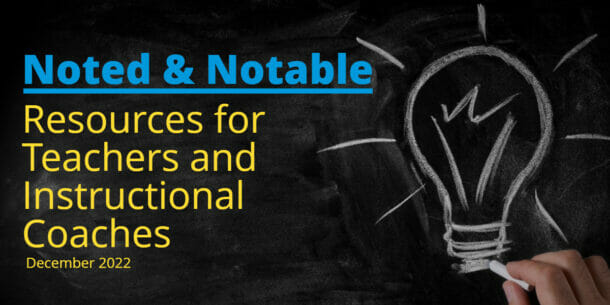Resources for Teachers and Instructional Coaches – December 2022

The end of the year is here and perhaps you’re catching up on good reads from December 2022. Maybe you’re looking for ideas for a strong 2023 start in the classroom or ways you can provide better professional development to teachers.
We’ve rounded up recent resources for teachers and instructional coaches and included highlights here.
Keep reading for our top picks for the December 2022 resources for more student and teacher learning in 2023. Find the highlights, article links, and related content below.
Classroom community is about relationships and student voice and choice
Coming back to school after winter break usually means resetting classroom routines. It’s important to incorporate ways to create and sustain community in your classroom, too.
Classroom community means that students feel safe, cared for, and purposeful.
This Edutopia article provides 6 ways teachers can help build and foster a strong classroom community.
Here are the first two strategies to incorporate these values into your daily teaching routines.
- Civic Responsibility
Teachers found that public rewards and punishments eroded a sense of community with competition and led children to comment about good and bad kids. By moving away from individual rewards and punishment, teachers helped children in small and large groups to see themselves as responsible for the community. -
I Need a Break
Telling students to take a time-out often escalates conflict by embarrassing them and leading to power struggles. In contrast, teachers described how they gave children autonomy to choose when they needed a break and when they were ready to return.
The key features of ensuring that breaks were supportive and effective were:
- Children took them by choice.
- Frequent class and individual conversations with teachers reviewed how breaks would work.
- The break space and/or activity was set up to be appealing and comforting to the children.
Read the rest of the classroom community-building strategies at Edutopia: 6 Ways to Create and Sustain Community
Working on positive student-teacher relationships? Get free resources for teachers and personalized support in AI Coach by Edthena.
Giving students feedback? Ask more questions
When feedback is presented unconstructively, it can bring learning to a halt.Feedback that sparks inquiry—feedback that is structured around open-ended and thought-provoking questions for students to consider—can pique students’ curiosity, encouraging them to explore further.
This ASCD article notes that asking more questions can make feedback to students more meaningful.
If you’re marking up student work with a red pen, maybe it’s time to consider giving question-based feedback instead. This resource for teachers has 3 tips for giving strong student feedback.
- Prior to an assignment, frame learning as a process.
Create an environment where the expectation is not to “get it right” the first time in order to encourage freethinking and an approach that’s more abstract. - During the assignment, begin with positive feedback and a question.
Even a positive statement can’t be left alone, such as “you did a good job.” Positive statements need to be unpacked. As students work, ask questions that prompt them to reflect on where their work is currently and the possibilities of where it can lead. Ask questions that open room for various ways students might examine a topic rather than questions that direct students toward one way of thinking. - After the assignment, provide feedback for how the work can continue to be cultivated.
There is no end to the growth of an assignment worth giving. Your feedback here might look like: The way you told the story was very intriguing. How could you create more beyond this to extend our collective learning on this topic?
To read more of the strategies for using questioning as a feedback strategy, check out the full article at ASCD: Using Questioning as a Feedback Strategy
Students getting frustrated with feedback? Read what Zaretta Hammond said about helping students embrace productive struggle.
Effective PLCs help teachers develop a vision for student improvement
Professional learning communities are common at schools as a time for teachers to share their growth areas and expertise.
This District Administration article has 8 ways instructional coaches or other school leaders can foster effective PLCs.
It notes, “Effective PLCs need disciplined, nurturing leaders to align priorities and set the pace for results-driven instruction.”
Here are some of the ways noted for building and refining PLCs in 2023:
- Set aligned goals
One of the essential tasks of the professional learning community is to set goals that align with the district/school mission, vision and initiatives. These tasks include carefully reviewing practices and trends to look for potential problems that need a targeted focus. - Offer support and resources
As a leader, your job is to offer support and provide the necessary resources, so teachers can stay on task and accomplish their goals promptly. Frequent check-ins and simple surveys help keep the communication channels open and the work running smoothly. - Metrics for progress monitoring
With learning outcomes firmly established, continue to define the metrics needed to monitor progress. Make sure your metrics are detailed.
Read the whole post about leading effective PLCs: 8 ways school leaders can develop more effective PLCs for teachers
Do effective PLCs need structure? Read why consistency is key for PLC protocols.
Did you miss last month’s edition of resources for teachers and coaches? Catch up on the November 2022 top resources for teachers and coaches!



